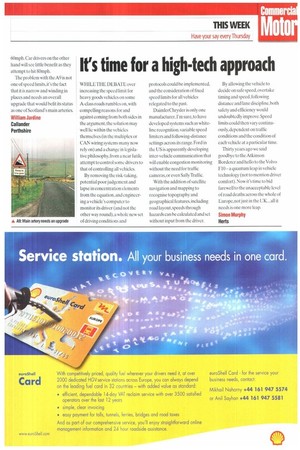It's time for a high-tech approach
Page 29

If you've noticed an error in this article please click here to report it so we can fix it.
WHILE THE DEBAYE over increasing the speed limit for heavy goods vehicles on some A-class roads rumbles on, with compelling reasons for and against coming from both sides in the argument, the solution may well lie within the vehicles themselves (in the multiplex or CAN wiring systems many now rely on) and a change in legislative philosophy, from a near futile attempt to control some drivers to that of controlling all vehicles.
By removing the risk-taking, potential poor judgement and lapse in concentration elements from the equation, and engineering a vehicle's computer to monitor its driver (and not the other way round), a whole new set of driving conditions and protocols could be implemented, and the consideration of fixed speed limits for all vehicles relegated to the past.
DaimlerChrysler is only one manufacturer, I'm sure, to have developed systems such as whiteline recognition, variable speed limiters and following-distance settings across its range. Ford in the US is apparently developing inter-vehicle communication that will enable congestion monitoring without the need for traffic cameras, or even SallyTraffic.
With the addition of satellite navigation and mapping to recognise topography and geographical features, including road layout, speeds through hazards can be calculated and set without input from the driver. By allowing the vehicle to decide on safe speed, overtake timing and speed,following distance and lane discipline, both safety and efficiency would undoubtedly improve. Speed limits could then vary, continuously, dependent on traffic conditions and the condition of each vehicle at a particular time.
Thirty years ago we said goodbye to the Atkinson Borderer and hello to the Volvo 110— a quantum leap in vehicle technology (not to mention driver comfort). Now it's time to bid farewell to the unacceptable level of road deaths across the whole of Europe, not just in the UK all it needs is one more leap.
Simon Murphy Hens


































































































































































































